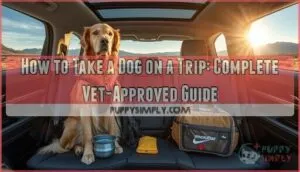This site is supported by our readers. We may earn a commission, at no cost to you, if you purchase through links.
You wouldn’t drive across the country without checking your oil and tire pressure. Your dog deserves the same level of preparation before hitting the road. Most pet owners underestimate how much advance planning goes into safe travel with dogs.
A last-minute trip can mean missing required vaccinations, overlooking destination-specific breed restrictions, or arriving at a hotel that doesn’t actually accept pets despite what the website claims.
Taking a dog on a trip requires coordination between veterinary visits, legal documentation, and practical gear preparation. The difference between a stressful journey and a smooth adventure often comes down to what you do in the weeks before departure. When you plan properly, your dog can travel safely and comfortably while you avoid preventable health emergencies and logistical headaches.
Table Of Contents
- Key Takeaways
- Pre-Trip Veterinary Preparation
- Researching Pet Travel Regulations
- Planning a Dog-Friendly Itinerary
- Choosing Pet-Friendly Accommodations
- Preparing Your Dog for Travel
- Packing Essentials for Your Dog
- Ensuring Dog Safety During Travel
- Dog-Friendly Activities and Destinations
- Frequently Asked Questions (FAQs)
- How can I find dog-friendly attractions and activities at my destination?
- How can I prevent my dog from getting stressed or anxious during travel?
- What should I feed my dog while traveling?
- How do I handle bathroom breaks on flights?
- Can my dog drink tap water at destinations?
- What if my dog gets injured far from home?
- Should I bring my dogs regular vet records?
- Conclusion
Key Takeaways
- Schedule a veterinary health check-up at least 12 weeks before departure to secure required vaccinations, health certificates, and address travel-specific medical needs like motion sickness or anxiety management.
- Research destination-specific pet regulations early since requirements vary dramatically—domestic travel needs 30-day health certificates while international trips demand USDA endorsement, microchips, and potential quarantine compliance.
- Plan your route with regular breaks every 2-3 hours, map emergency veterinary clinics along the way, and confirm pet policies directly with accommodations since online listings often hide breed restrictions and fees.
- Use crash-tested restraints or secured crates in vehicles, monitor your dog’s temperature vigilantly during travel, and pack familiar items plus a complete first aid kit to prevent common emergencies.
Pre-Trip Veterinary Preparation
Before you pack a single bag, your first stop should be your veterinarian’s office. A pre-trip visit helps catch potential health issues and ensures your dog is ready for the demands of travel. Here’s what you need to cover with your vet before hitting the road.
Scheduling a Health Check-Up
Before packing a single chew toy, book your dog’s health check-up with a veterinarian at least 12 weeks before departure. This appointment timing allows room for vaccinations and any needed treatments.
Your veterinarian will assess:
- Physical fitness and health indicators
- Parasite screening and prevention
- Travel anxiety or motion sickness risks
- Health certificate requirements and legal documentation
For international travel, a vet-issued health certificate is mandatory. Bring your complete travel itinerary for specific advice.
Updating Vaccinations and Microchip
During that same visit, confirm your dog’s vaccinations match current legal requirements and your destination’s rules. For international travel, rabies documentation and specific antibody testing may be necessary. Preventative healthcare is essential for canine health.
Most dogs already follow recommended vaccination schedules—94.7% keep up with their vet’s advice. Update your dog’s microchip registration too. Dogs with registered microchips have 52% recovery rates compared to just 22% without them, giving you real peace of mind on the road.
Obtaining Health Certificates
Once vaccinations are current, ask your veterinarian about health certificates. Interstate travel generally requires a Certificate of Veterinary Inspection valid for 30 days. International trips need USDA endorsement, which adds $38 plus potential blood test costs starting at $121.
Airlines set their own requirements—most want certificates issued within 5-10 days before departure. Digital passports using blockchain technology are emerging, offering tamper-proof verification at participating clinics.
Discussing Calming Aids and Medications
After securing your health certificate, talk through anxiety management options with your vet. Travel stress affects many dogs, and you’ve got solid choices:
- Calming supplements work for mild anxiety—hemp-based chews and probiotics show positive results within days
- Prescription options like fluoxetine help severe cases but need advance planning
- Pheromone therapy reduces separation anxiety through synthetic maternal scents
- Motion sickness remedies prevent nausea on long rides
- Travel sedation carries serious risks—airlines discourage it due to cardiovascular dangers
Veterinary guidance ensures you pick what’s safest for your dog’s specific needs.
Researching Pet Travel Regulations
Before you book your tickets or hit the road, you need to understand the rules that govern pet travel. Regulations vary widely depending on your destination, your mode of transportation, and whether you’re crossing state lines or international borders.
Here’s what you need to research to keep your trip legal and stress-free.
Domestic and International Travel Rules
You’ll encounter vastly different pet travel regulations depending on where you’re headed. Starting August 2024, all dogs entering the United States need medical documentation, microchips, and must be at least six months old. Here’s what matters most:
| Travel Type | Key Requirements |
|---|---|
| Domestic U.S. | Health certificates valid 30 days; state-specific vaccination records |
| International | Country-specific entry requirements; quarantine policies vary widely |
| High-Risk Rabies Countries | Temporary import suspensions; additional documentation validity checks |
Breed restrictions and import statistics show that over 287,000 dogs entered the U.S. in 2006 alone, with 25% unvaccinated. Research your destination’s quarantine policies early.
Airline and Train Pet Policies
When comparing airline pet policies with train travel, the differences can catch you off guard. Nearly 2 million pets board flights annually, with standard pet fares around $125 per carrier.
Airlines like Southwest limit flights to five carriers and require carrier dimensions under 18x14x9 inches. Amtrak restricts dogs to 20 pounds for trips under seven hours.
Both demand health forms and have breed restrictions worth checking early.
Service Animal Requirements
Service animals under ADA Compliance follow different pet travel regulations than typical airline pet policies. No breed restrictions apply here, but your dog must perform disability-related tasks.
Handler responsibilities include maintaining control and answering only two questions from staff. Training standards don’t require certification, but fraudulent claims carry legal penalties.
Unlike regular pets requiring pet health certificates, service animals travel fee-free with proper behavior and task training.
Documentation and Entry Restrictions
You might think a quick health certificate is enough, but international travel demands much more precision. Documentation errors can strand your dog in quarantine for months or result in entry denial.
Critical requirements you’ll need:
- Certificate Validity: U.S. airlines require health certificates no older than 10 days, while the EU mandates dating within 10 days of entry.
- Microchip Standards: The U.S. and EU both require microchip documentation with rabies vaccinations and detailed medical records.
- Quarantine Policies: Australia enforces 10-30 day quarantines; Hawaii can require up to 120 days without compliant paperwork.
- Electronic Certification: Over 40 countries now accept digital submissions through USDA’s platform, greatly speeding approvals.
Planning a Dog-Friendly Itinerary
Your dog’s comfort and safety depend on more than just reaching your destination. A well-planned itinerary accounts for your pet’s physical needs and potential emergencies along the way.
Here are the key elements to think about when mapping out your travel route.
Mapping Pet-Friendly Routes
Planning your route with a digital map makes all the difference. Over 41% of dog owners now use dedicated apps to locate pet-friendly accommodations and rest stops along their journey.
These platforms help you build a dog-friendly itinerary with infrastructure growth supporting your needs—from highway rest areas to hotels offering custom features. Service integration means real-time updates keep your trip stress-free.
Finding Dog-Friendly Parks and Stops
Finding reliable dog-friendly parks along your route keeps your pup happy and healthy. Park review sites now aggregate ratings from multiple platforms to verify pet-friendly parks before you arrive. Highway rest stops operated by major chains feature fenced areas at over 400 locations nationwide.
- City park access varies widely—Boise leads with 7.6 parks per 100,000 residents
- Regional park highlights include scenic trail access and separate small-dog sections
- Tech trip solutions filter dog-friendly stops by amenities and real-time conditions
- Pet-friendly accommodations databases integrate park locations with lodging options
Scheduling Regular Breaks and Exercise
Once you’ve mapped dog-friendly stops, build in breaks every 2 to 3 hours for potty stops and exercise. Older dogs and smaller breeds need breaks closer to every 1.5 hours. Keep each stop at least 15 minutes to allow gentle walking rather than intense play.
This break frequency prevents dehydration and cuts travel stress by 70% while meeting your pet’s hydration needs and behavioral benefits naturally.
Emergency Veterinary Service Locations
Beyond planning rest stops, identify emergency veterinary offices along your route before departure. Urban coverage offers clinics within 5 to 15 minutes, while rural access may require 1 to 1.5 hours of driving. Save these urgent care contacts in your phone:
- BluePearl locations nationwide
- VCA Animal Hospitals with emergency hours
- Local 24/7 emergency hospital options
- Mobile services for remote areas
- Teaching hospitals near city centers
This preparation protects your pet during unexpected health crises.
Choosing Pet-Friendly Accommodations
Finding a place to stay with your dog takes more than a quick internet search. Not all pet-friendly accommodations are created equal, and policies can vary widely even within the same hotel chain.
Here’s what you need to know to choose lodging that works for both you and your dog.
Researching Hotels and Vacation Rentals
When booking dog-friendly hotels or vacation rentals, start with digital platforms that filter for pet-friendly accommodations. About 75% of hotels now welcome pets, though breed restrictions on dogs like Pit Bulls or Rottweilers remain common.
Expect pet fee averages around $76 per stay, plus possible security deposits. Look for amenity offerings like relief areas and welcome treats to make your pup feel at home.
Contacting Properties for Pet Policies
After you’ve found promising pet-friendly accommodations online, call directly to confirm pet policy clarity. Nearly 80% of properties allowing pets impose breed restrictions or hidden pet fees that online listings don’t always reveal.
Ask about documentation requests and pre-approval processes upfront. Knowing the real cost and rules before booking prevents unpleasant surprises when you arrive with your dog.
Puppy-Proofing Temporary Lodging
Once you arrive at your pet-friendly accommodations, hazard removal and floor safety take priority. Common household dangers cause over 72% of dog-related injuries in temporary lodging. Secure dog safety through these steps:
- Remove toxic plants, medications, and small choking hazards
- Cover electrical cords and use physical barriers like pet gates
- Lock trash bins for proper waste management
- Set up a dog bed, cleaning supplies, and emergency prep kit
This proactive dog care protects your companion throughout your stay.
Avoiding Hidden Fees and Restrictions
Why do hotel pet fees vary so wildly? Average charges hit $81.60 per stay, but you can dodge these costs by booking direct with chains like Kimpton or Red Roof Inn. Watch for breed restrictions and weight limits that affect 80% of rentals.
Airline policies add another layer—always confirm documentation requirements and flight restrictions before you purchase tickets.
Preparing Your Dog for Travel
Getting your dog comfortable with travel takes time and patience. Start well before your trip to give them a chance to adjust to new routines and equipment.
Here’s how to prepare your dog for a smooth journey.
Introducing Travel Gear and Carriers
Your dog won’t magically feel at home in a pet carrier without practice. Start introducing travel gear at least two weeks before your trip to build positive associations. Follow these acclimation techniques:
- Place the travel crate in a familiar room with the door open and a favorite blanket inside.
- Use treats and praise to encourage voluntary exploration of airline-approved carriers.
- Gradually increase time spent inside with comfort features like toys.
- Practice short sessions with gear size guidelines matching your dog’s measurements.
Acclimating to Car Rides or Crates
Nearly 65% of dogs experience anxiety during car rides. Start gradual car acclimation by letting your dog explore the stationary vehicle with treats and praise.
Use a travel restraint system or crate for proper restraint. Keep initial trips under 30 minutes to reduce car anxiety.
Positive reinforcement during each session prevents crate training regression and builds confidence for longer journeys ahead.
Managing Anxiety and Motion Sickness
About 25% of dogs struggle with motion sickness, and certain breeds like Boxers and Border Collies face higher risks.
Calming aids such as pheromone sprays or L-theanine supplements can ease dog anxiety. Medication options like meclizine or prescription anti-anxiety drugs work well for severe cases.
Gradual exposure to the travel environment paired with proper ventilation reduces both motion sickness and stress effectively.
Maintaining Routine and Comfort
Keeping your dog’s routine intact acts like an anchor in unfamiliar territory. Stick to usual feeding times and exercise schedules to reduce stress by up to 61%.
Pack familiar bedding and toys to create comfort zones anywhere you go. About 82% of owners bring their dog’s regular bed on trips, and this simple habit cuts anxiety-related behaviors markedly while supporting healthy travel habits.
Packing Essentials for Your Dog
Packing for your dog isn’t as simple as tossing a bag of kibble in the trunk. You need to think through the essentials that keep your dog comfortable, safe, and healthy on the road.
Here’s what should make it into your travel bag before you hit the highway.
Food, Water, and Medications
Pack enough dog food to last your entire trip plus an extra day for delays. Bring familiar brands to avoid food allergies or digestive upset.
Your dog needs about 1 ounce of water per pound of body weight daily, so carry portable bowls and bottled water.
Don’t forget current medications and anti-nausea travel meds like Cerenia if your vet recommended them for motion sickness.
Travel Crate, Harness, and Leash
Your travel crate must let your dog stand, turn around, and lie down comfortably with at least three inches of headroom. Look for hard-sided, leak-proof materials with ventilation on all four sides.
A safety restraint tested for crash protection keeps your dog secure in the car, while nylon or leather leashes work best during rest stops.
Airlines require IATA-compliant crates, so check pet restraints regulations before booking.
Favorite Toys and Bedding
Bringing familiar items from home aids your dog’s comfort during unfamiliar travel situations. Toy selection matters—nine out of ten dogs prefer treat-dispensing options like frozen Kongs over regular toys, which keep them occupied for hours.
These calming aids reduce anxiety by recreating your dog’s normal environment.
- Doughnut-shaped travel beds with orthopedic foam provide joint support
- Machine-washable bedding maintains hygiene at multiple stops
- Squeaky toys that mimic prey satisfy natural instincts
- Water-resistant materials withstand spills and accidents
First Aid Kit and Cleaning Supplies
Beyond toys and bedding, your first aid kit and cleaning supplies form your safety net on the road. Over 80% of dog owners lack a pet first aid kit despite common emergency scenarios like cuts or heatstroke during travel.
Include your veterinarian’s contact information and local emergency clinic details for each destination.
| Kit Essentials | Cleaning Protocols | Specialized Components |
|---|---|---|
| Gauze pads, antiseptic wipes | Extra poop bags | Digital thermometer |
| Non-stick bandages | Pet wipes, dry shampoo | Emergency blanket |
| Antibiotic ointment | Stain remover | Tick remover |
| Disposable gloves | Lint rollers | Instant cold packs |
Ensuring Dog Safety During Travel
Keeping your dog safe during travel requires planning ahead for different scenarios. From securing them properly in the car to managing temperature changes, each safety measure helps protect your pet on the road.
Here’s what you need to focus on to keep your dog safe throughout your journey.
Car Safety and Restraints
Unrestrained dogs become dangerous projectiles in accidents, turning a 60-pound companion into a significant force during even minor collisions. Body restraint crash tests show that certified restraints can prevent this, while legal mandates in several states now require proper vehicle safety measures.
In a crash, an unrestrained 60-pound dog becomes a dangerous projectile—certified restraints and state laws now address this serious safety risk
- Use a crash-tested car safety body restraint or approved travel crate secured in the back seat
- Avoid truck beds entirely—over 100,000 dogs die yearly from falls or ejections
- Check your state’s restraint laws to avoid fines and assure compliance
- Never let your dog ride with their head out the window or unrestrained
The risks of unrestrained dogs extend beyond their own safety. They can distract drivers and endanger everyone in the vehicle.
Temperature Control and Climate Adaptation
When summer temperatures spike, heatstroke kills over a quarter of affected dogs—brachycephalic breeds face four times the risk. You need to monitor temperature control vigilantly and time travel during cooler hours for overheating prevention.
Breed sensitivity matters: double-coated dogs adapt well to cold but struggle in heat, while Chihuahuas risk hypothermia. Climate acclimation takes 7 to 60 days.
Product selection like cooling mats aids your dog’s health needs during adaptation.
Preventing Escape and Lost Pets
Without proper identification and secure gear, you’re rolling the dice on losing your dog. Microchip technology and GPS tracking devices cut search times from 12 hours to just 3. Use double-leash setups and secure leashes with visible ID tags listing emergency contacts.
Training preparation with “wait” and “come” commands reduces escape attempts by 40%. Update your dog’s collar and microchip registration before departure.
Monitoring Health on The Road
Your dog’s health can shift fast on the road. Check hydration every few hours and watch for excessive panting or drooling. Wearable technology like smart collars tracks heart rate and temperature in real time.
Brachycephalic breeds face triple the risk of heat stress.
Pack your first aid kit and medications. Map emergency veterinary clinics along your route for quick access.
Dog-Friendly Activities and Destinations
Once you’ve arrived safely, the real fun begins. Finding the right activities and destinations keeps your dog happy while making the trip memorable for both of you.
Here’s how to choose wisely and avoid places that might put your dog at risk.
Visiting Parks, Beaches, and Trails
Before you head to dogfriendly parks or dogfriendly beaches, check leash regulations and seasonal restrictions. Up to 89% of public parks require leashes in main areas, and many beaches ban dogs during peak tourist months.
Keep wildlife impact minimal by following trail etiquette:
- Stay on marked paths to prevent plant damage
- Dispose of waste properly to protect water quality
- Avoid nesting zones where shorebirds face up to 15% population decline
Your pet depends on your awareness of these rules during travel.
Exploring Dog-Friendly Cities
When you’re choosing dog-friendly cities for travel, prioritize places with high walkability and urban dog parks. Denver boasts 65% dog ownership and nearly universal park access within a 10-minute walk, while Tampa leads with dozens of dog-friendly restaurants and off-leash beaches. These policy interventions reflect global trends toward pet-friendly rentals and dog-friendly accommodations.
| City | Dog Ownership Rate | Key Features |
|---|---|---|
| Tampa, FL | High | 12+ off-leash parks, 300+ dog-friendly restaurants |
| Denver, CO | 65% | 96% within 10-min walk to dog-friendly parks |
| Omaha, NE | 70% | Top safety metrics for pets |
| Dallas, TX | Moderate | 79% pet-friendly rental listings |
| Miami, FL | 56% | High walkability, 248 sunny days annually |
Research dog-friendly activities before arrival to better your pet’s comfort and safety during urban exploration.
Choosing Activities Based on Dog’s Needs
After exploring urban destinations, match activities to your dog’s individual profile. Sporting breeds like Labradors need 90 minutes of vigorous exercise daily, while herding breeds require 60 minutes plus mental enrichment through puzzle toys. Senior dogs benefit from low-impact walks, and puppies thrive on short training bursts.
Monitor stress by watching for elevated cortisol signs during travel. Owner preferences matter too—custom activities reduce separation anxiety and keep your dog comfortable throughout the trip.
Destinations to Avoid With Dogs
While planning dog-friendly vacation destinations, skip places with climate extremes like Alaska or Louisiana where temperatures threaten safety. Hawaii’s quarantine policies complicate entry, and Maui scored just 2.3 out of 50 points for limited amenities.
Avoid countries with high disease prevalence or poor animal welfare—Vietnam and China lack adequate veterinary care.
Focus instead on dog-friendly cities and accommodations designed for comfortable, safe vacations to avoid dogs experiencing preventable health risks.
Frequently Asked Questions (FAQs)
How can I find dog-friendly attractions and activities at my destination?
Think of your trip research like building a map to buried treasure. Online databases and tourism boards reveal dog-friendly parks, restaurants, and activities.
Social media and community forums add local events and pet-friendly vacation destinations.
How can I prevent my dog from getting stressed or anxious during travel?
Start preparing your dog weeks in advance with gradual travel acclimation using short trips.
Pack familiar item comfort like blankets or toys.
Consider calming aid options such as pheromones or CBD supplements under veterinary guidance to manage dog anxiety effectively.
What should I feed my dog while traveling?
Stick with your dog’s regular dog food while traveling. Familiar meals prevent gastrointestinal upset and maintain digestive health.
Pack enough for the trip, use airtight food storage, bring portable water bowls, and follow your usual feeding guidelines for dogs.
How do I handle bathroom breaks on flights?
Most dogs can hold their bladder for six to ten hours during flights. Use absorbent pads in pet carriers to prevent in-cabin accidents.
Visit airport relief areas before boarding and limit water intake beforehand.
Can my dog drink tap water at destinations?
Your golden retriever starts vomiting hours after drinking from a hotel sink—a scenario no traveler wants. Tap water risks vary by region, so carry bottled water or use filtration options, especially where contaminant levels differ from home.
What if my dog gets injured far from home?
Stay calm and locate the nearest emergency vet using your phone or GPS. Transport your dog carefully to minimize further injury.
Having travel insurance coverage and a first aid kit helps manage unexpected veterinary costs and immediate care needs.
Should I bring my dogs regular vet records?
Pack your pup’s medical records because emergency treatment, boarding access, and border crossings demand health records.
Vaccination certificates and health checks satisfy legal compliance while enabling insurance claims when veterinarian care becomes necessary.
Conclusion
Think of trip preparation like building a safety net beneath your dog’s adventure. When you’ve checked the veterinary requirements, mapped your route, and packed the right gear, you’re not just taking a dog on a trip—you’re creating the conditions for safe travel.
The effort you put into planning now prevents emergencies later. Your dog depends on your foresight to stay healthy and comfortable throughout the journey.

















